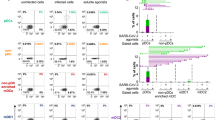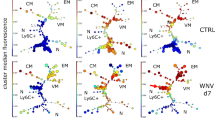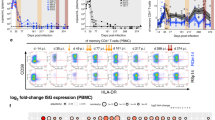Abstract
Pathogenic HIV infections of humans and simian immunodeficiency virus (SIV) infections of rhesus macaques are characterized by generalized immune activation and progressive CD4+ T cell depletion. In contrast, natural reservoir hosts for SIV, such as sooty mangabeys, do not progress to AIDS and show a lack of aberrant immune activation and preserved CD4+ T cell populations, despite high levels of SIV replication. Here we show that sooty mangabeys have substantially reduced levels of innate immune system activation in vivo during acute and chronic SIV infection and that sooty mangabey plasmacytoid dendritic cells (pDCs) produce markedly less interferon-α in response to SIV and other Toll-like receptor 7 and 9 ligands ex vivo. We propose that chronic stimulation of pDCs by SIV and HIV in non-natural hosts may drive the unrelenting immune system activation and dysfunction underlying AIDS progression. Such a vicious cycle of continuous virus replication and immunopathology is absent in natural sooty mangabey hosts.
This is a preview of subscription content, access via your institution
Access options
Subscribe to this journal
Receive 12 print issues and online access
$209.00 per year
only $17.42 per issue
Buy this article
- Purchase on Springer Link
- Instant access to full article PDF
Prices may be subject to local taxes which are calculated during checkout






Similar content being viewed by others
Accession codes
Accessions
GenBank/EMBL/DDBJ
References
Hazenberg, M.D. et al. T-cell division in human immunodeficiency virus (HIV)-1 infection is mainly due to immune activation: a longitudinal analysis in patients before and during highly active antiretroviral therapy (HAART). Blood 95, 249–255 (2000).
Hellerstein, M.K. et al. Subpopulations of long-lived and short-lived T cells in advanced HIV-1 infection. J. Clin. Invest. 112, 956–966 (2003).
Finkel, T.H. et al. Apoptosis occurs predominantly in bystander cells and not in productively infected cells of HIV- and SIV-infected lymph nodes. Nat. Med. 1, 129–134 (1995).
Moir, S. et al. Decreased survival of B cells of HIV-viremic patients mediated by altered expression of receptors of the TNF superfamily. J. Exp. Med. 200, 587–599 (2004).
Kottilil, S. et al. Enhanced susceptibility to CD95-mediated natural killer cell death and turnover induced by HIV viremia. J. Acquir. Immune Defic. Syndr. 46, 151–159 (2007).
Barron, M.A., Blyveis, N., Palmer, B.E., MaWhinney, S. & Wilson, C.C. Influence of plasma viremia on defects in number and immunophenotype of blood dendritic cell subsets in human immunodeficiency virus 1–infected individuals. J. Infect. Dis. 187, 26–37 (2003).
Grossman, Z., Meier-Schellersheim, M., Paul, W.E. & Picker, L.J. Pathogenesis of HIV infection: what the virus spares is as important as what it destroys. Nat. Med. 12, 289–295 (2006).
Giorgi, J.V. et al. Shorter survival in advanced human immunodeficiency virus type 1 infection is more closely associated with T lymphocyte activation than with plasma virus burden or virus chemokine coreceptor usage. J. Infect. Dis. 179, 859–870 (1999).
Hahn, B.H., Shaw, G.M., De Cock, K.M. & Sharp, P.M. AIDS as a zoonosis: scientific and public health implications. Science 287, 607–614 (2000).
Gordon, S.N. et al. Short-lived infected cells support virus replication in naturally SIV-infected sooty mangabeys: implications for AIDS pathogenesis. J. Virol. 82, 3725–3735 (2008).
Gordon, S.N. et al. Severe depletion of mucosal CD4+ T cells in AIDS-free simian immunodeficiency virus–infected sooty mangabeys. J. Immunol. 179, 3026–3034 (2007).
Sumpter, B. et al. Correlates of preserved CD4+ T cell homeostasis during natural, nonpathogenic simian immunodeficiency virus infection of sooty mangabeys: implications for AIDS pathogenesis. J. Immunol. 178, 1680–1691 (2007).
Silvestri, G. et al. Nonpathogenic SIV infection of sooty mangabeys is characterized by limited bystander immunopathology despite chronic high-level viremia. Immunity 18, 441–452 (2003).
Silvestri, G. et al. Divergent host responses during primary simian immunodeficiency virus SIVsm infection of natural sooty mangabey and nonnatural rhesus macaque hosts. J. Virol. 79, 4043–4054 (2005).
Banchereau, J. et al. Immunobiology of dendritic cells. Annu. Rev. Immunol. 18, 767–811 (2000).
Coates, P.T. et al. Dendritic cell subsets in blood and lymphoid tissue of rhesus monkeys and their mobilization with Flt3 ligand. Blood 102, 2513–2521 (2003).
Fonteneau, J.F. et al. Human immunodeficiency virus type 1 activates plasmacytoid dendritic cells and concomitantly induces the bystander maturation of myeloid dendritic cells. J. Virol. 78, 5223–5232 (2004).
Biron, C.A. Interferons α and β as immune regulators—a new look. Immunity 14, 661–664 (2001).
Kolumam, G.A., Thomas, S., Thompson, L.J., Sprent, J. & Murali-Krishna, K. Type I interferons act directly on CD8 T cells to allow clonal expansion and memory formation in response to viral infection. J. Exp. Med. 202, 637–650 (2005).
Liu, Y.J. IPC: professional type 1 interferon–producing cells and plasmacytoid dendritic cell precursors. Annu. Rev. Immunol. 23, 275–306 (2005).
Iwasaki, A. & Medzhitov, R. Toll-like receptor control of the adaptive immune responses. Nat. Immunol. 5, 987–995 (2004).
Beignon, A.S. et al. Endocytosis of HIV-1 activates plasmacytoid dendritic cells via Toll-like receptor–viral RNA interactions. J. Clin. Invest. 115, 3265–3275 (2005).
Meier, A. et al. MyD88-dependent immune activation mediated by human immunodeficiency virus type 1–encoded Toll-like receptor ligands. J. Virol. 81, 8180–8191 (2007).
Barrat, F.J. et al. Nucleic acids of mammalian origin can act as endogenous ligands for Toll-like receptors and may promote systemic lupus erythematosus. J. Exp. Med. 202, 1131–1139 (2005).
Pichlmair, A. & Reis e Sousa, C. Innate recognition of viruses. Immunity 27, 370–383 (2007).
Herbeuval, J.P. et al. Regulation of TNF-related apoptosis-inducing ligand on primary CD4+ T cells by HIV-1: role of type I IFN–producing plasmacytoid dendritic cells. Proc. Natl. Acad. Sci. USA 102, 13974–13979 (2005).
Honda, K. et al. IRF-7 is the master regulator of type I interferon–dependent immune responses. Nature 434, 772–777 (2005).
Tamura, T., Yanai, H., Savitsky, D. & Taniguchi, T. The IRF family transcription factors in immunity and oncogenesis. Annu. Rev. Immunol. 26, 535–584 (2008).
Akira, S., Uematsu, S. & Takeuchi, O. Pathogen recognition and innate immunity. Cell 124, 783–801 (2006).
Markowitz, M. et al. A novel antiviral intervention results in more accurate assessment of human immunodeficiency virus type 1 replication dynamics and T cell decay in vivo. J. Virol. 77, 5037–5038 (2003).
Giavedoni, L.D., Velasquillo, M.C., Parodi, L.M., Hubbard, G.B. & Hodara, V.L. Cytokine expression, natural killer cell activation and phenotypic changes in lymphoid cells from rhesus macaques during acute infection with pathogenic simian immunodeficiency virus. J. Virol. 74, 1648–1657 (2000).
Ferlazzo, G. Natural killer and dendritic cell liaison: recent insights and open questions. Immunol. Lett. 101, 12–17 (2005).
Barry, A.P. et al. Depletion of CD8+ cells in sooty mangabey monkeys naturally infected with simian immunodeficiency virus reveals limited role for immune control of virus replication in a natural host species. J. Immunol. 178, 8002–8012 (2007).
Dunham, R. et al. The AIDS resistance of naturally SIV-infected sooty mangabeys is independent of cellular immunity to the virus. Blood 108, 209–217 (2006).
Kamath, A.T., Sheasby, C.E. & Tough, D.F. Dendritic cells and NK cells stimulate bystander t cell activation in response to TLR agonists through secretion of IFN-α, IFN-β and IFN-γ. J. Immunol. 174, 767–776 (2005).
Jego, G. et al. Plasmacytoid dendritic cells induce plasma cell differentiation through type I interferon and interleukin 6. Immunity 19, 225–234 (2003).
Reis e Sousa, C. Toll-like receptors and dendritic cells: for whom the bug tolls. Semin. Immunol. 16, 27–34 (2004).
Marie, I., Smith, E., Prakash, A. & Levy, D.E. Phosphorylation-induced dimerization of interferon regulatory factor 7 unmasks DNA binding and a bipartite transactivation domain. Mol. Cell. Biol. 20, 8803–8814 (2000).
Honda, K., Yanai, H., Takaoka, A. & Taniguchi, T. Regulation of the type I IFN induction: a current view. Int. Immunol. 17, 1367–1378 (2005).
Sato, M. et al. Distinct and essential roles of transcription factors IRF-3 and IRF-7 in response to viruses for IFN-α/β gene induction. Immunity 13, 539–548 (2000).
Zhang, S.Y. et al. Human Toll-like receptor–dependent induction of interferons in protective immunity to viruses. Immunol. Rev. 220, 225–236 (2007).
Binder, D., Fehr, J., Hengartner, H. & Zinkernagel, R.M. Virus-induced transient bone marrow aplasia: major role of interferon-αβ during acute infection with the noncytopathic lymphocytic choriomeningitis virus. J. Exp. Med. 185, 517–530 (1997).
Lin, Q., Dong, C. & Cooper, M.D. Impairment of T and B cell development by treatment with a type I interferon. J. Exp. Med. 187, 79–87 (1998).
Heikenwalder, M. et al. Lymphoid follicle destruction and immunosuppression after repeated CpG oligodeoxynucleotide administration. Nat. Med. 10, 187–192 (2004).
Wang, T. et al. Toll-like receptor 3 mediates West Nile virus entry into the brain causing lethal encephalitis. Nat. Med. 10, 1366–1373 (2004).
Gowen, B.B. et al. TLR3 deletion limits mortality and disease severity due to phlebovirus infection. J. Immunol. 177, 6301–6307 (2006).
Le Goffic, R. et al. Detrimental contribution of the Toll-like receptor (TLR)3 to influenza A virus–induced acute pneumonia. PLoS Pathog. 2, e53 (2006).
Herbeuval, J.P. & Shearer, G.M. HIV-1 immunopathogenesis: how good interferon turns bad. Clin. Immunol. 123, 121–128 (2007).
Kaser, A., Nagata, S. & Tilg, H. Interferon α augments activation-induced T cell death by upregulation of Fas (CD95/APO-1) and Fas ligand expression. Cytokine 11, 736–743 (1999).
Hyrcza, M.D. et al. Distinct transcriptional profiles in ex vivo CD4+ and CD8+ T cells are established early in human immunodeficiency virus type 1 infection and are characterized by a chronic interferon response as well as extensive transcriptional changes in CD8+ T cells. J. Virol. 81, 3477–3486 (2007).
Sedaghat, A.R. et al. Chronic CD4+ T cell activation and depletion in human immunodeficiency virus type I infection: type I interferon-mediated disruption of T cell dynamics. J. Virol. 82, 1870–1883 (2008).
Tilton, J.C. et al. Human immunodeficiency virus viremia induces plasmacytoid dendritic cell activation in vivo and diminished α interferon production in vitro. J. Virol. 82, 3997–4006 (2008).
Bosinger, S.E. et al. Gene expression profiling of host response in models of acute HIV infection. J. Immunol. 173, 6858–6863 (2004).
Brenchley, J.M. et al. Microbial translocation is a cause of systemic immune activation in chronic HIV infection. Nat. Med. 12, 1365–1371 (2006).
Pandrea, I.V. et al. Acute loss of intestinal CD4+ T cells is not predictive of simian immunodeficiency virus virulence. J. Immunol. 179, 3035–3046 (2007).
Decalf, J. et al. Plasmacytoid dendritic cells initiate a complex chemokine and cytokine network and are a viable drug target in chronic HCV patients. J. Exp. Med. 204, 2423–2437 (2007).
Stewart, T.A. Neutralizing interferon α as a therapeutic approach to autoimmune diseases. Cytokine Growth Factor Rev. 14, 139–154 (2003).
Bochud, P.-Y.M.B., Telenti, A. & Calandra, T. Innate immunogenetics: a tool for exploring new frontiers of host defence. Lancet Infect. Dis. 7, 531–542 (2007).
Picker, L.J. et al. Insufficient production and tissue delivery of CD4+ memory T cells in rapidly progressive simian immunodeficiency virus infection. J. Exp. Med. 200, 1299–1314 (2004).
Rossio, J.L. et al. Inactivation of human immunodeficiency virus type 1 infectivity with preservation of conformational and functional integrity of virion surface proteins. J. Virol. 72, 7992–8001 (1998).
Acknowledgements
The authors would like to thank B. Weaver, J. Skvarich, B. O'Hara and M. Mulligan for their help coordinating blood draws from HIV-infected humans, S. Ehnert and E. Strobert for their care of the study animals, B. Lawson and D. Lee for performing the SIVsm and SIVmac239 viral load assays, J. Ingersoll for performing the HIV viral load assays, A. McCrary for assistance with cloning and sequencing, K. Dalbey for help with running ELISAs, H. Yi for help with electron microscopy, J. Bess and J. Lifson at the US National Cancer Institute for providing the aldrithiol-2–inactivated SIV and HIV strains and microvesicle controls, 3M Pharmaceuticals for providing the R-848 and anonymous human volunteers for providing blood samples for these studies. We would also like to thank G. Silvestri for his input. We gratefully acknowledge the support of the US National Institutes of Health grants R01 HL075766 and R01 AI049155, the Yerkes National Primate Research Center Grant RR000165 and the Emory Center for AIDS Research Grant P30-AI-50409. The authors apologize for not citing all relevant publications due to space limitations.
Author information
Authors and Affiliations
Contributions
J.N.M., A.P.B. and M.B.F. designed the experiments, and J.N.M. and A.P.B. conducted most of them. T.H.V. sequenced genes involved in the TLR signaling pathway under the supervision of S.I.S., N.K. performed gene expression analyses, R.C. and S.K. developed assays and reagents that paved the way for this work, F.J.B. and R.L.C. provided the TLR antagonists and contributed to planning inhibition experiments, and M.B.F. supervised the overall project. J.N.M., A.P.B. and M.B.F. analyzed the data and J.N.M. and M.B.F. wrote the manuscript.
Corresponding author
Ethics declarations
Competing interests
R.L.C. and F.J.B. are employed by Dynavax Technologies, which is developing inhibitors of TLR7 and TLR9 for therapeutic use.
Supplementary information
Supplementary Text and Figures
Supplementary Figures 1–4, Supplemetary Tables 1–3 and Supplementary Methods (PDF 1265 kb)
Rights and permissions
About this article
Cite this article
Mandl, J., Barry, A., Vanderford, T. et al. Divergent TLR7 and TLR9 signaling and type I interferon production distinguish pathogenic and nonpathogenic AIDS virus infections. Nat Med 14, 1077–1087 (2008). https://doi.org/10.1038/nm.1871
Received:
Accepted:
Published:
Issue Date:
DOI: https://doi.org/10.1038/nm.1871
This article is cited by
-
TLR9 polymorphism correlates with immune activation, CD4 decline and plasma IP10 levels in HIV patients
BMC Infectious Diseases (2019)
-
Viral subversion of B cell responses within secondary lymphoid organs
Nature Reviews Immunology (2018)
-
Restriction of HIV-1-based lentiviral vectors in adult primary marrow-derived and peripheral mobilized human CD34+ hematopoietic stem and progenitor cells occurs prior to viral DNA integration
Retrovirology (2016)
-
HIV-1 immune activation induces Siglec-1 expression and enhances viral trans-infection in blood and tissue myeloid cells
Retrovirology (2015)
-
Chloroquine and beyond: exploring anti-rheumatic drugs to reduce immune hyperactivation in HIV/AIDS
Retrovirology (2015)



